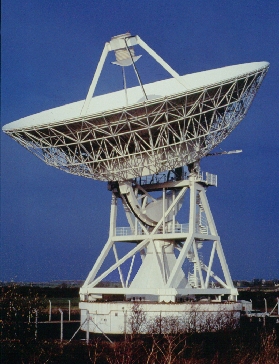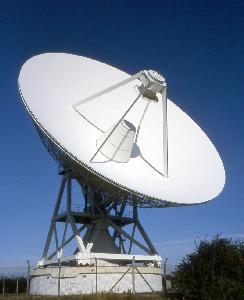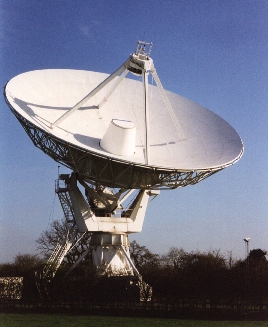The Multi-Element-Radio-Linked-Interferometer-Network (MERLIN)
In the early 1990's the array, now called MERLIN, was extended to include a new 32m telescope at Cambridge and other improvements made to to significantly its sensitivity.
The 32m uses a modified cassegrain design using a secondary reflector close to the prime focus of the telescope. By adjusting the shape of the primary reflector away from a parabola and making appropriate corrections to the shape of the secondary reflector the efficiency (that is, the ratio of the the effective collecting area to the total area) was condsiderably improved over a standard parabolic surface. The temperatures of the main elements of the telescope are continuously measured and fed into a thermal model of the structure. This allows a pointing correction to be made to compensate for tilts introduced by temperature differences across the structure.
A key feature of the 32m radiotelescope is its frequency flexibility. The feed horns and receivers are mounted on a carousel whose rotation axis is offset from the centre line of the telescope. By rotation of this carousel under remote control the different receiver systems can be brought to the focal point of the telescope thus allowing rapid changes of frequency.
The new telescope gave a significant increase in the overall size of the array such that the resolution of MERLIN at radio wavelengths now equals or exceeds that of the Hubble Space telescope in the visible part of the spectrum.
Three enhancements were made to the array to significantly increase its sensitivity.Sets of new receivers based on the use of HEMT transistors were built and cooled to around 15K using a helium gas refrigeration system. This gave the major part of the sensitivity improvement but in addition, the microwave links were re-engineered to carry both hands of polarization, each with a bandwidth of 15 MHz, and a new correlator was built using two-bit rather than single-bit digitization.
Since 1996 an engineering programme has been in progress to give the MKII and E-Systems telescopes frequency flexibility. Carousels, similar to that of the 32m telescope, are now in position on the three E-Systems telescopes covered by a new cone housing. (Compare with the Knockin image in the MTRLI section.) The first dual frequency (5 and 22 GHz)observing session took place from the autumn of 1997 to the spring of 1998. It was thus possible to observe at 22 GHz, where the weather can have a significant impact on the quality of the data, when conditions were optimum.
Work is now underway on the next step in the development of the MERLIN array, called e-MERLIN.





